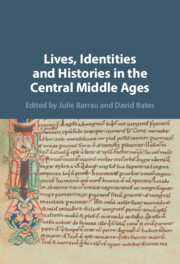Book contents
- Lives, Identities and Histories in the Central Middle Ages
- Lives, Identities and Histories in the Central Middle Ages
- Copyright page
- Contents
- Figures
- Contributors
- Abbreviations
- Introduction
- Part I Entwined Lives and Multiple Identities
- Part II Historians, Lawyers and Exegetes: Writing Lives and Identities
- 9 Ademar of Chabannes and the Normans:
- 10 Lives, Identities and the Historians of the Normans
- 11 Ruth in the Twelfth Century:
- 12 Jacob and Esau and the Interplay of Jewish and Christian Identities in the Middle Ages
- 13 Identity, Gender and History in Wace’s Roman de Rou and Roman de Brut
- 14 Glanvill:
- 15 Dunstan, Edgar and the History of Not-So-Recent Events
- Index
11 - Ruth in the Twelfth Century:
The Multiple Identities of a Foreign Converted Widow from Scripture
from Part II - Historians, Lawyers and Exegetes: Writing Lives and Identities
Published online by Cambridge University Press: 24 September 2021
- Lives, Identities and Histories in the Central Middle Ages
- Lives, Identities and Histories in the Central Middle Ages
- Copyright page
- Contents
- Figures
- Contributors
- Abbreviations
- Introduction
- Part I Entwined Lives and Multiple Identities
- Part II Historians, Lawyers and Exegetes: Writing Lives and Identities
- 9 Ademar of Chabannes and the Normans:
- 10 Lives, Identities and the Historians of the Normans
- 11 Ruth in the Twelfth Century:
- 12 Jacob and Esau and the Interplay of Jewish and Christian Identities in the Middle Ages
- 13 Identity, Gender and History in Wace’s Roman de Rou and Roman de Brut
- 14 Glanvill:
- 15 Dunstan, Edgar and the History of Not-So-Recent Events
- Index
Summary
This chapter explores twelfth-century readings of the book of Ruth, seemingly a short pastoral story. The limited scale and scope of the book is particularly revealing of the careful ingenuity and engaged earnestness with which clerics and monks approached scripture, a fact that may be obvious but is often obfuscated by the apparent repetitions from exegete to exegete, the deep unfamiliarity to a modern eye of the intellectual tools and methods they used and the sheer textual mass of medieval exegesis. There is still a lot that historians can learn from reading those texts. In the book of Ruth, the fluid identities of the two female protagonists and their eventful lives, alongside the clear figure of a Boaz-Christ that elevated the theological status of the whole book, were scrutinised, assimilated and reinvented by twelfth-century clerics, monks and masters who had their own identities, life trajectories and zeitgeist to imagine and to shape through their words.
- Type
- Chapter
- Information
- Lives, Identities and Histories in the Central Middle Ages , pp. 203 - 226Publisher: Cambridge University PressPrint publication year: 2021



